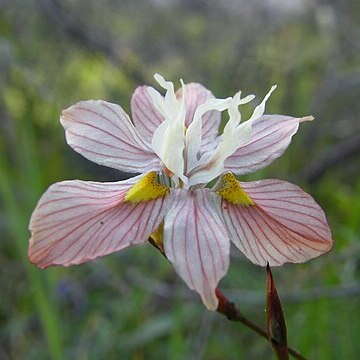Perennial herb, geophyte, 0.15-0.45 m high; corm tunics light brown, fibres coarse, vertically ridged; stem with 3-5 branches or rarely simple. Leaves (1)2 or 3, linear, erect or spreading, trailing, margins plane, undulate or crisped. Spathes herbaceous, acute, apex dry, attenuate. Inflorescence with yellow, cream-coloured, brick-red or bicoloured flowers; tepals unequal, reflexed, outer 18-25 mm long. Stamens: filaments 4-6 mm long, united up to lower half; anthers 2-3 mm long; pollen yellow. Ovary 2-3 mm long, ovoid; style branches 5-8 mm long. Flowering time Sept.-Nov. Capsule globose to broadly obovoid.
Cormous geophyte, 150-450 mm tall, several-branched. Leaves 1 or 2 (or 3 elsewhere), margins often crisped. Flowers enclosed in green, obtuse spathes, yellow, cream or red, occasionally bicoloured, tepal limbs lightly reflexed, filaments united in lower half, pollen red, style branches diverging, crests erect.
Cormous geophyte, 15-45 cm. Leaves 2 or 3, margins often crisped. Flowers yellow, cream-coloured or brick-red, sometimes bicoloured.

